The value of good farm infrastructure is often not fully recognised until changes are made and the investment has been utilised.
Roscommon sheep and suckler farmer Shane Moore has had such an experience with a new sheep shed built at the end of 2020 which is already transforming his farming system.
Shane, Kelly and their son Ryan (four) run a flock of 145 mature ewes alongside 75 yearling hoggets and 10 suckler cows on 30ha of grassland a short distance outside Athleague.
The farm is fragmented and is split into three divisions five to six miles apart.

There is a skylight in every bay with Shane keen to have as much natural light entering the shed as possible.

The centre slatted area is split down the centre with three double pens and four single pen sections.
The farm joined the Teagasc BETTER farm sheep programme a couple of years ago and recently hosted an online farm walk. The focus of the event centred on farm infrastructure and, in particular, the importance of good infrastructure in facilitating efficient flock expansion.
Flock expansion
Shane has been gradually increasing flock numbers since joining the programme and current numbers include 145 mature ewes, 34 yearling ewes rearing lambs and 42 run dry.
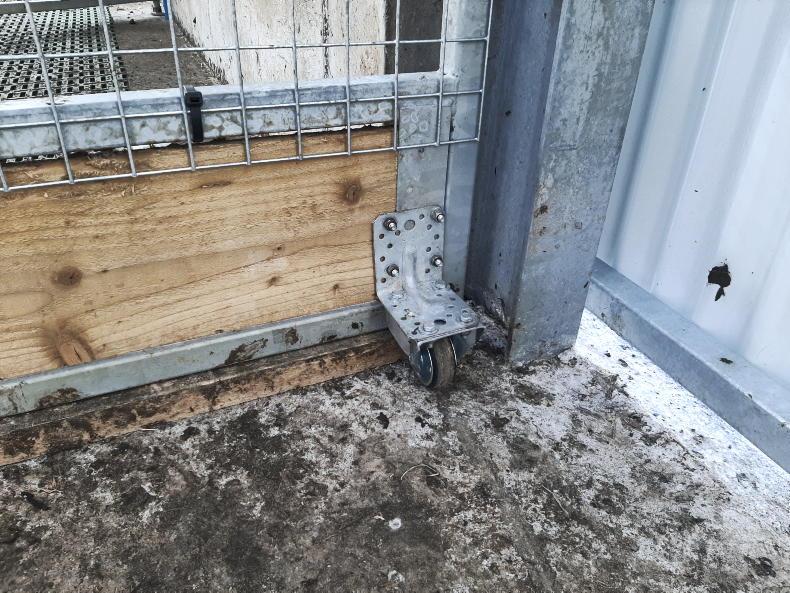
Shane added a simple wheel to the hinged feeding barrier to take any excess pressure of the hinges when opened.
His target is to increase flock numbers to 200 mature ewes and their replacements. As he works full-time off farm, this must be achieved in a sustainable manner both in terms of labour efficiency and delivering a worthwhile return to justify the increase.
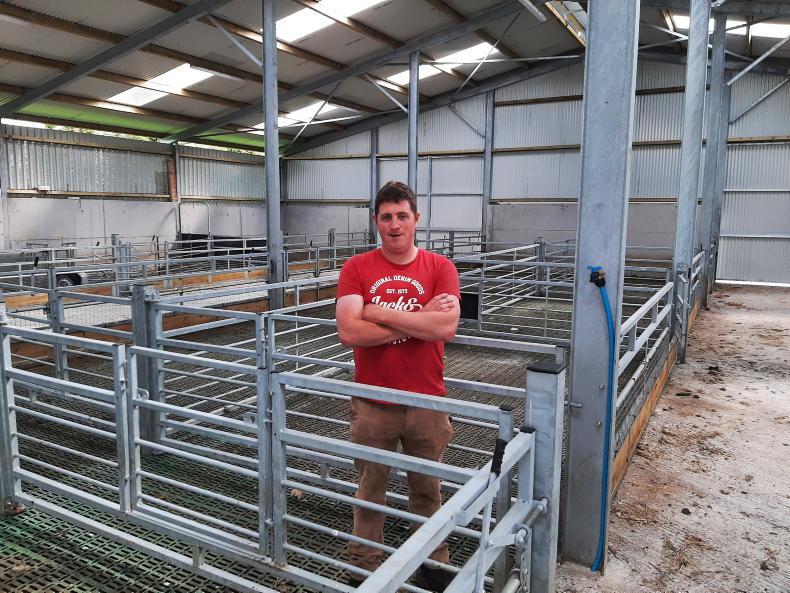
Shane Moore, Athleague, Co Roscommon.
The availability of animal housing was identified as a limiting factor to increasing numbers, with outwintering of higher numbers of ewes not feasible with off-farm employment.
Facilities were also inadequate to allow a tight lambing spread and taking a prolonged period of time off work to lamb ewes was not a runner.
Shed deliberations
After a taxing winter in 2019 working long hours and covering significant distances to winter grazing, a decision was taken to invest in a new sheep shed. The first port of call and possibly the most important task was to visit a number of different sheds.
Shane explains: “I was only going to build the shed once and I didn’t want to be sorry. Visiting sheds and getting ideas of what you want in your own is something I would recommend strongly.”
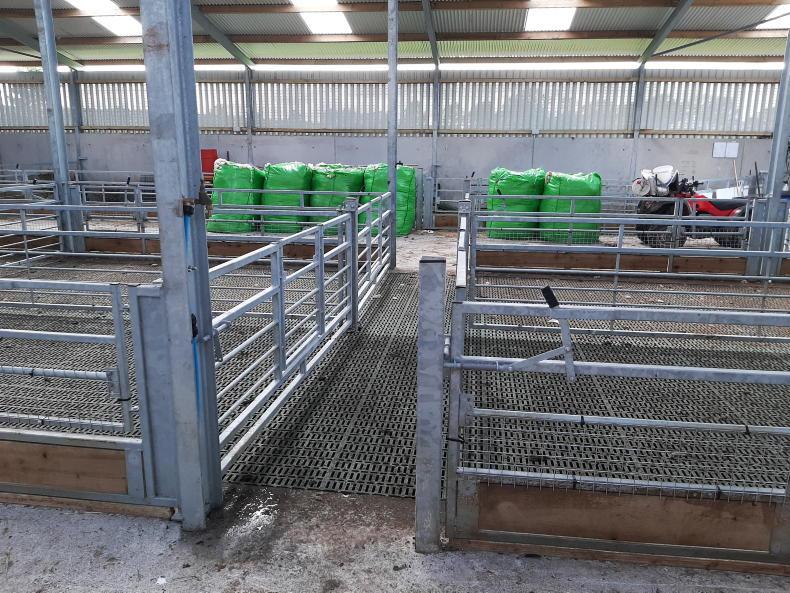
The passageway allowing access from one side of the shed to the other is hailed by Shane as one of the best features.
Speaking at the event, Teagasc business and technology adviser Michael Conroy highlighted the importance of completing a project plan. Important points to include are a realistic timescale and a financial budget, with significant investments having the potential to put huge pressure on farm cashflow.
The period of time from planning the shed at the drawing stage to when the sod was broken to start the shed was a year and a half, with planning permission and TAMS approval the main reasons for the protracted time frame.
Once the shed construction started, it was a quick build. Digging of the foundation starting on 21 September 2020 and ewes were housed in January 2021.
Shed layout
The shed, which is five bays long (24m), was built with a combination of slatted accommodation and straw bedding.
As detailed in Figure 1, there is a double-slatted tank running down the centre of the shed. 
This is split with a spine wall which holds the centre penning and also negates the use of heavier steel runners to carry the plastic slats. Sheep feed along the passageways, with no walk-through troughs presents.
Shane says: “I wanted the shed to be as efficient as possible on labour input and central to this for me was narrow pens that you do not need to access daily. The straw-bedded penning is also designed for feeding only along the front of penning.”

The black Stokbord can be slid up along the gate allowing the dividing gate to lie parallel with either of the two centre gates without being impeded by the water trough.
Shane also planned the shed to double up for handling sheep during the summer months and this was another reason for opting for a slatted floor area.
He has been working on a system in recent months of setting up a mobile handling pen in the straw-bedded area and using the slatted pens as holding pens. This is working well in keeping sheep cleaner and it cuts down on the need for cleaning post-handling.
Slatted floor
The slatted penning is split into three double-penned sections with regard the length and four standard-sized pens.
The straw bedding is divided into individual pens and these pens will be used for triplet-bearing ewes and replacement ewe hoggets along with other animals which may require preferential treatment and housing on a straw bed over a slatted floor.
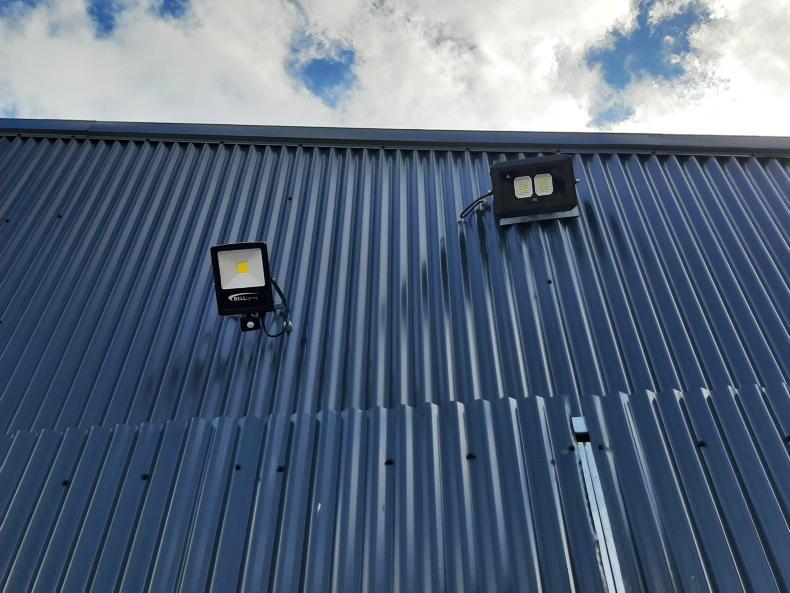
The sensor light on the left allows safe access to the shed when dark while Shane is also pleased with the main LED outdoor lights.
There is space for eight large-framed mature ewes to eat unrestricted along a 4.8m feeding barrier, with feeding space the limitation for holding more ewes in pens over lying space.
Shane says there may be scope, if needed, to add an extra ewe in pens where the batch is of smaller stature.
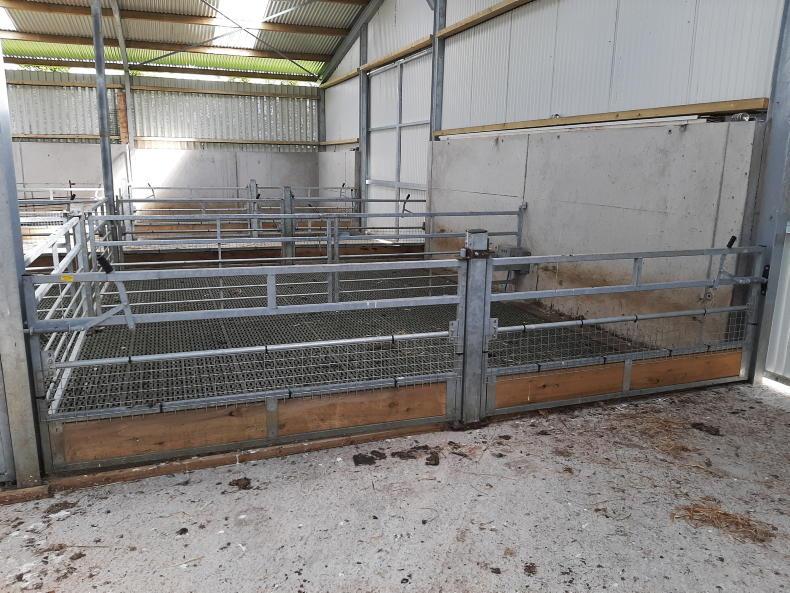
The feeding barriers in the end pens are divided into two with a hinged barrier on the end that swings out to meet the barrier on the front of the straw-bedded pens and thereby allowing smooth movement of sheep around the shed.
The tank is 1.5m deep in the main, with two 2.4m deep sections at both ends for agitation. This provides ample slurry storage to house ewes for a 100-day winter, which is likely to be the case when the farm’s stocking rate reaches its target level.
Valuable features
The fact that Shane invested time in looking at other sheds and put much consideration in to the planning stage is clear to be seen in a number of valuable features.
The first of these is a walkway in the centre of the slatted shed linking both passageways.
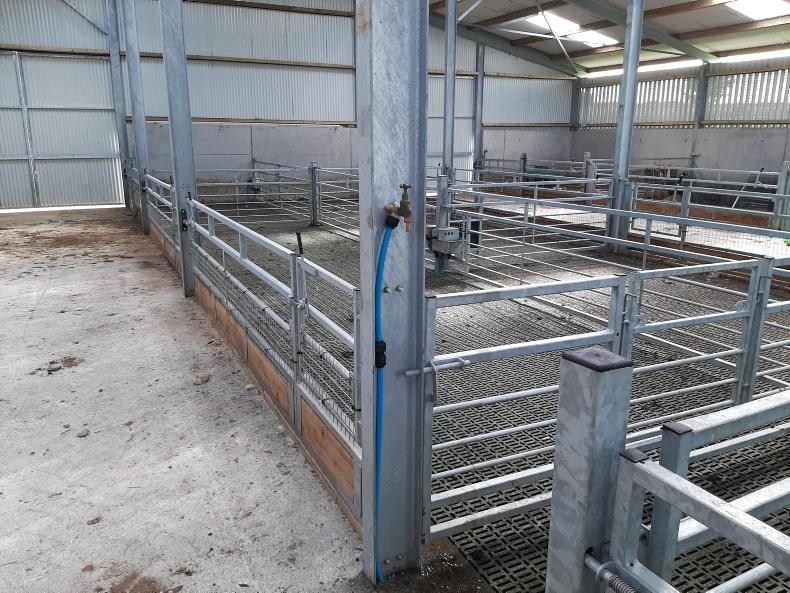
The insertion of water taps at either end of the walkway through the centre of the shed allows quick access to water for lambing pens set up in the feeding passageways during lambing.
“It may not seem like much, but I had seen other sheds where farmers said it was a nuisance having to go outside or walk through pens to move from one side of the shed to the other. It is amazing how many times you would use this area during lambing in particular. The passageway foregoes a small area of penning and I think it is one of the best features.”

The posts holding the feeding barriers are all removable allowing the shed to be used during the summer months for alternative uses if desired.
As mentioned previously, the shed was designed to double up as a handling unit during the summer months and, as such, the smooth movement of sheep is important. Feeding barriers are split strategically with gates hanging as internal pen divisions.
Gates can also link across the passageway allowing sheep to be moved easily from the slatted area to the straw-bedded penning.
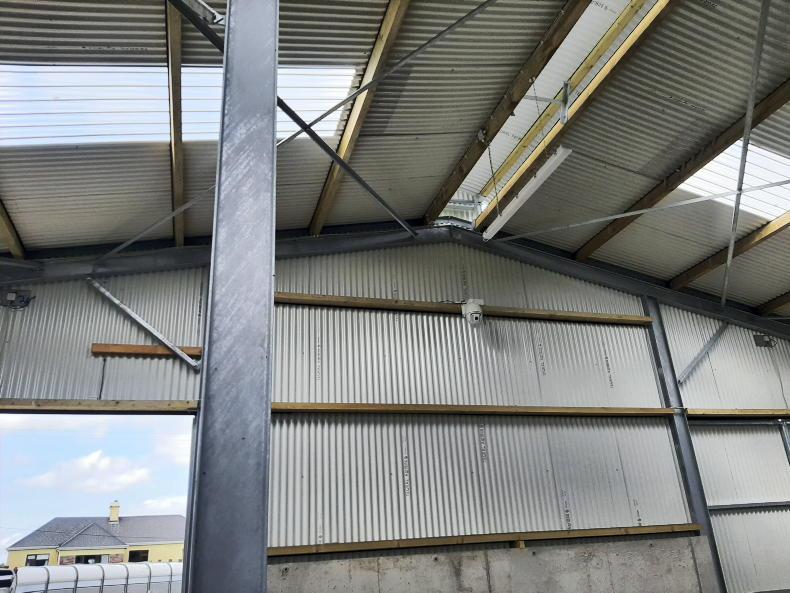
A camera which operates off WiFi allows Shane to keep an eye on stock without having to visit the shed.
The posts used to hang these gates are all set in steel sleeves fixed in the concrete and can be removed easily. This is especially beneficial in the straw-bedded area as this could double up to store hay, straw, etc.
Shane has also affixed a wheel to the hinged feeding barriers to take pressure off the posts and barriers when opened.
Another well thought-out feature is the presence of a tap at each end of the walkway through the pens.
Shane included these to have a water source close to hand at lambing to service individual lambing pens which are set up in the feeding passages.
Another aspect that instantly hits you when in the shed is how bright and airy it is. There are 20 skylights fitted in the roof, each of which is also fitted with safety bars. The open inlet, which overhangs he eaves above the vented sheeting, enhances air flow while also providing another natural light source.
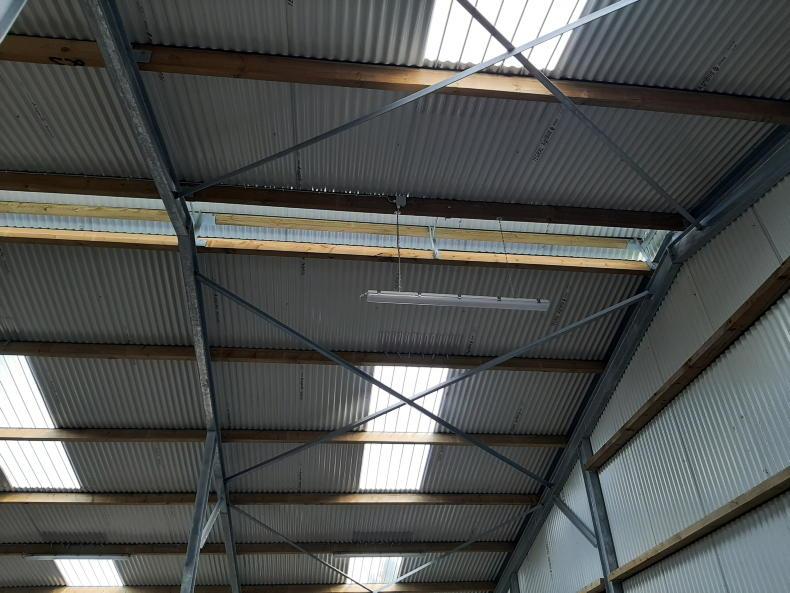
In addition to lots of rooflights there is also ample lighting with one located over each of the straw-bedded pens and one located over each slatted floored section.
In addition, there is lighting above each pen. There is also a sensor light outside the door which is used as the main entrance and LED outdoor lights are also present to accommodate the fact that a lot of work will be carried out under the cover of darkness.
The total cost of the shed was €114,500. This includes €13,610 in VAT, which can be redeemed while Shane was also eligible for maximum grant aid of €48,000 (60% of a maximum investment of €80,000) as a young trained farmer under the Targeted Agriculture Modernisation Scheme (TAMS II). This left the net cost of the development of €52,890 or €331 per ewe.
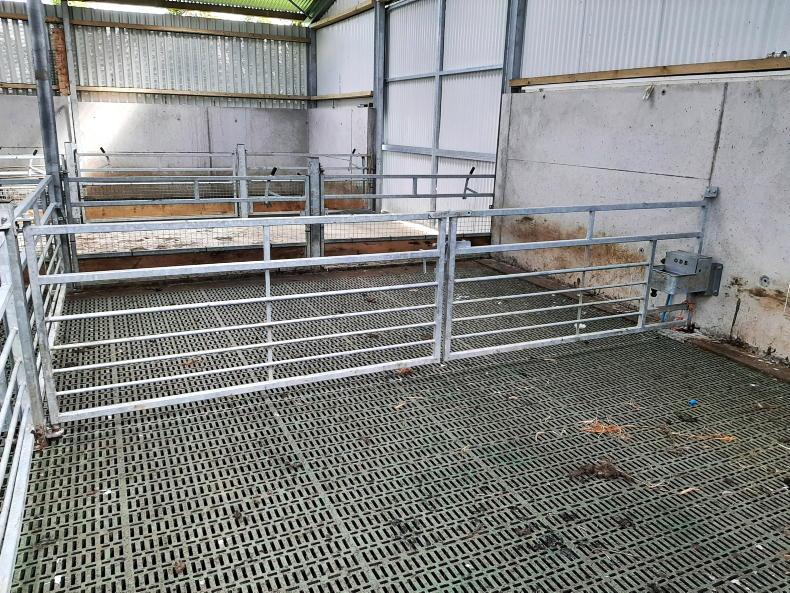
The gates dividing the slatted area into two can also be opened in the middle to provide quick access to each pen.
It is a big investment on the face of it but is easy to justify given the working lifetime of the shed. Were the investment not made, flock numbers would remain stagnant while building the shed also brings a much improved work-life balance. On the online event, Teagasc sheep specialist Damian Costello calculated that the decision to opt for a slatted floored area over straw bedding added about €16,000 to the cost (€18,000 minus €2,000 cost for a solid concrete floor).
He said that while the additional cost is substantial, it delivers in terms of reducing labour and could end up being a wise investment given the rising cost and lower availability of straw.
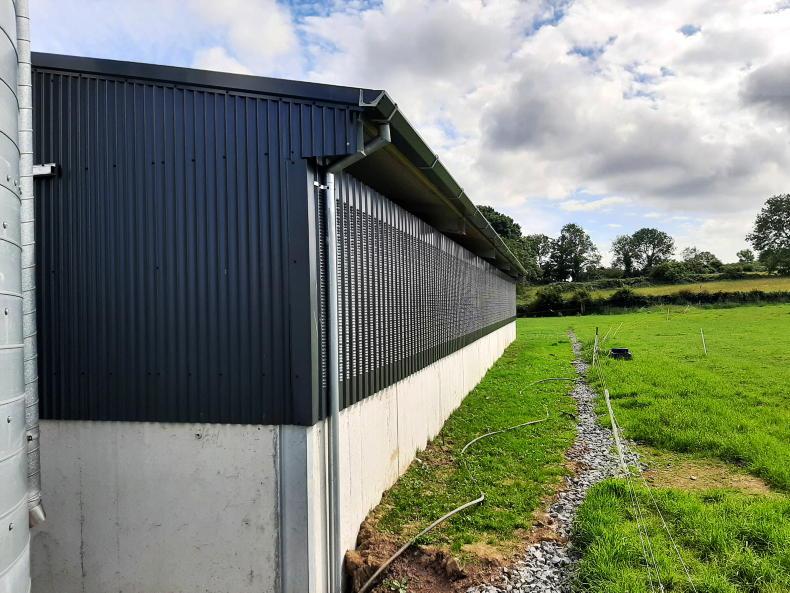
An overhang with an unobstructed air inlet is a necessary and worthwhile addition under TAMS II.
Shane advises other young farmers to consider taking advantage of TAMS for animal housing, handling equipment or fencing. He encourages anyone starting out in planning a shed to put plenty of thought into the process and also avail of the experience of those working on the project.
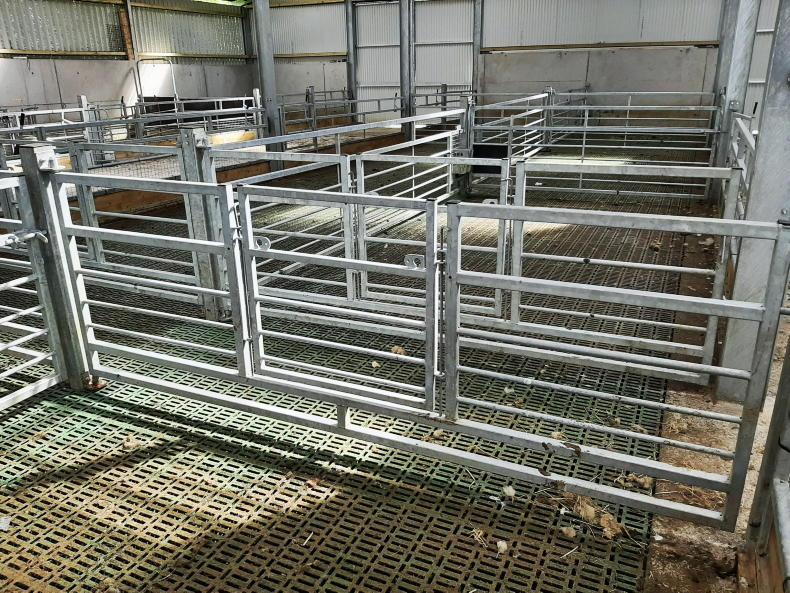
There is a gate in the centre running alongside the passageway to aid quicker movement of sheep from one pen to the next without opening the main gates.
“Everyone I had working on the shed brought good experience and lots of tips which contributed to a better finish. David Neilan carried out the digging while David Kennedy from Creta Construction did all the concrete works.
“Lyons Steel Works Limited provided and erected the shed structure, Enda Blighe did the plumbing, while another local man, Tommy Farrell, did the electrical works and provided advice on lighting. O’Donnell Engineering supplied the penning.”
The value of good farm infrastructure is often not fully recognised until changes are made and the investment has been utilised.
Roscommon sheep and suckler farmer Shane Moore has had such an experience with a new sheep shed built at the end of 2020 which is already transforming his farming system.
Shane, Kelly and their son Ryan (four) run a flock of 145 mature ewes alongside 75 yearling hoggets and 10 suckler cows on 30ha of grassland a short distance outside Athleague.
The farm is fragmented and is split into three divisions five to six miles apart.

There is a skylight in every bay with Shane keen to have as much natural light entering the shed as possible.

The centre slatted area is split down the centre with three double pens and four single pen sections.
The farm joined the Teagasc BETTER farm sheep programme a couple of years ago and recently hosted an online farm walk. The focus of the event centred on farm infrastructure and, in particular, the importance of good infrastructure in facilitating efficient flock expansion.
Flock expansion
Shane has been gradually increasing flock numbers since joining the programme and current numbers include 145 mature ewes, 34 yearling ewes rearing lambs and 42 run dry.

Shane added a simple wheel to the hinged feeding barrier to take any excess pressure of the hinges when opened.
His target is to increase flock numbers to 200 mature ewes and their replacements. As he works full-time off farm, this must be achieved in a sustainable manner both in terms of labour efficiency and delivering a worthwhile return to justify the increase.

Shane Moore, Athleague, Co Roscommon.
The availability of animal housing was identified as a limiting factor to increasing numbers, with outwintering of higher numbers of ewes not feasible with off-farm employment.
Facilities were also inadequate to allow a tight lambing spread and taking a prolonged period of time off work to lamb ewes was not a runner.
Shed deliberations
After a taxing winter in 2019 working long hours and covering significant distances to winter grazing, a decision was taken to invest in a new sheep shed. The first port of call and possibly the most important task was to visit a number of different sheds.
Shane explains: “I was only going to build the shed once and I didn’t want to be sorry. Visiting sheds and getting ideas of what you want in your own is something I would recommend strongly.”

The passageway allowing access from one side of the shed to the other is hailed by Shane as one of the best features.
Speaking at the event, Teagasc business and technology adviser Michael Conroy highlighted the importance of completing a project plan. Important points to include are a realistic timescale and a financial budget, with significant investments having the potential to put huge pressure on farm cashflow.
The period of time from planning the shed at the drawing stage to when the sod was broken to start the shed was a year and a half, with planning permission and TAMS approval the main reasons for the protracted time frame.
Once the shed construction started, it was a quick build. Digging of the foundation starting on 21 September 2020 and ewes were housed in January 2021.
Shed layout
The shed, which is five bays long (24m), was built with a combination of slatted accommodation and straw bedding.
As detailed in Figure 1, there is a double-slatted tank running down the centre of the shed. 
This is split with a spine wall which holds the centre penning and also negates the use of heavier steel runners to carry the plastic slats. Sheep feed along the passageways, with no walk-through troughs presents.
Shane says: “I wanted the shed to be as efficient as possible on labour input and central to this for me was narrow pens that you do not need to access daily. The straw-bedded penning is also designed for feeding only along the front of penning.”

The black Stokbord can be slid up along the gate allowing the dividing gate to lie parallel with either of the two centre gates without being impeded by the water trough.
Shane also planned the shed to double up for handling sheep during the summer months and this was another reason for opting for a slatted floor area.
He has been working on a system in recent months of setting up a mobile handling pen in the straw-bedded area and using the slatted pens as holding pens. This is working well in keeping sheep cleaner and it cuts down on the need for cleaning post-handling.
Slatted floor
The slatted penning is split into three double-penned sections with regard the length and four standard-sized pens.
The straw bedding is divided into individual pens and these pens will be used for triplet-bearing ewes and replacement ewe hoggets along with other animals which may require preferential treatment and housing on a straw bed over a slatted floor.

The sensor light on the left allows safe access to the shed when dark while Shane is also pleased with the main LED outdoor lights.
There is space for eight large-framed mature ewes to eat unrestricted along a 4.8m feeding barrier, with feeding space the limitation for holding more ewes in pens over lying space.
Shane says there may be scope, if needed, to add an extra ewe in pens where the batch is of smaller stature.

The feeding barriers in the end pens are divided into two with a hinged barrier on the end that swings out to meet the barrier on the front of the straw-bedded pens and thereby allowing smooth movement of sheep around the shed.
The tank is 1.5m deep in the main, with two 2.4m deep sections at both ends for agitation. This provides ample slurry storage to house ewes for a 100-day winter, which is likely to be the case when the farm’s stocking rate reaches its target level.
Valuable features
The fact that Shane invested time in looking at other sheds and put much consideration in to the planning stage is clear to be seen in a number of valuable features.
The first of these is a walkway in the centre of the slatted shed linking both passageways.

The insertion of water taps at either end of the walkway through the centre of the shed allows quick access to water for lambing pens set up in the feeding passageways during lambing.
“It may not seem like much, but I had seen other sheds where farmers said it was a nuisance having to go outside or walk through pens to move from one side of the shed to the other. It is amazing how many times you would use this area during lambing in particular. The passageway foregoes a small area of penning and I think it is one of the best features.”

The posts holding the feeding barriers are all removable allowing the shed to be used during the summer months for alternative uses if desired.
As mentioned previously, the shed was designed to double up as a handling unit during the summer months and, as such, the smooth movement of sheep is important. Feeding barriers are split strategically with gates hanging as internal pen divisions.
Gates can also link across the passageway allowing sheep to be moved easily from the slatted area to the straw-bedded penning.

A camera which operates off WiFi allows Shane to keep an eye on stock without having to visit the shed.
The posts used to hang these gates are all set in steel sleeves fixed in the concrete and can be removed easily. This is especially beneficial in the straw-bedded area as this could double up to store hay, straw, etc.
Shane has also affixed a wheel to the hinged feeding barriers to take pressure off the posts and barriers when opened.
Another well thought-out feature is the presence of a tap at each end of the walkway through the pens.
Shane included these to have a water source close to hand at lambing to service individual lambing pens which are set up in the feeding passages.
Another aspect that instantly hits you when in the shed is how bright and airy it is. There are 20 skylights fitted in the roof, each of which is also fitted with safety bars. The open inlet, which overhangs he eaves above the vented sheeting, enhances air flow while also providing another natural light source.

In addition to lots of rooflights there is also ample lighting with one located over each of the straw-bedded pens and one located over each slatted floored section.
In addition, there is lighting above each pen. There is also a sensor light outside the door which is used as the main entrance and LED outdoor lights are also present to accommodate the fact that a lot of work will be carried out under the cover of darkness.
The total cost of the shed was €114,500. This includes €13,610 in VAT, which can be redeemed while Shane was also eligible for maximum grant aid of €48,000 (60% of a maximum investment of €80,000) as a young trained farmer under the Targeted Agriculture Modernisation Scheme (TAMS II). This left the net cost of the development of €52,890 or €331 per ewe.

The gates dividing the slatted area into two can also be opened in the middle to provide quick access to each pen.
It is a big investment on the face of it but is easy to justify given the working lifetime of the shed. Were the investment not made, flock numbers would remain stagnant while building the shed also brings a much improved work-life balance. On the online event, Teagasc sheep specialist Damian Costello calculated that the decision to opt for a slatted floored area over straw bedding added about €16,000 to the cost (€18,000 minus €2,000 cost for a solid concrete floor).
He said that while the additional cost is substantial, it delivers in terms of reducing labour and could end up being a wise investment given the rising cost and lower availability of straw.

An overhang with an unobstructed air inlet is a necessary and worthwhile addition under TAMS II.
Shane advises other young farmers to consider taking advantage of TAMS for animal housing, handling equipment or fencing. He encourages anyone starting out in planning a shed to put plenty of thought into the process and also avail of the experience of those working on the project.

There is a gate in the centre running alongside the passageway to aid quicker movement of sheep from one pen to the next without opening the main gates.
“Everyone I had working on the shed brought good experience and lots of tips which contributed to a better finish. David Neilan carried out the digging while David Kennedy from Creta Construction did all the concrete works.
“Lyons Steel Works Limited provided and erected the shed structure, Enda Blighe did the plumbing, while another local man, Tommy Farrell, did the electrical works and provided advice on lighting. O’Donnell Engineering supplied the penning.”





















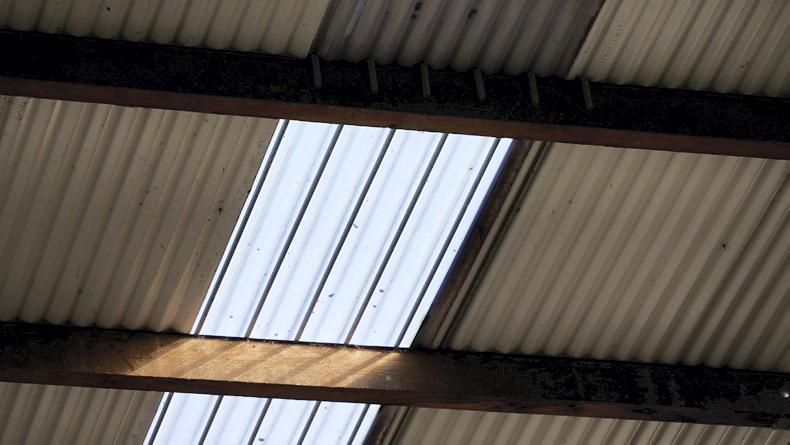
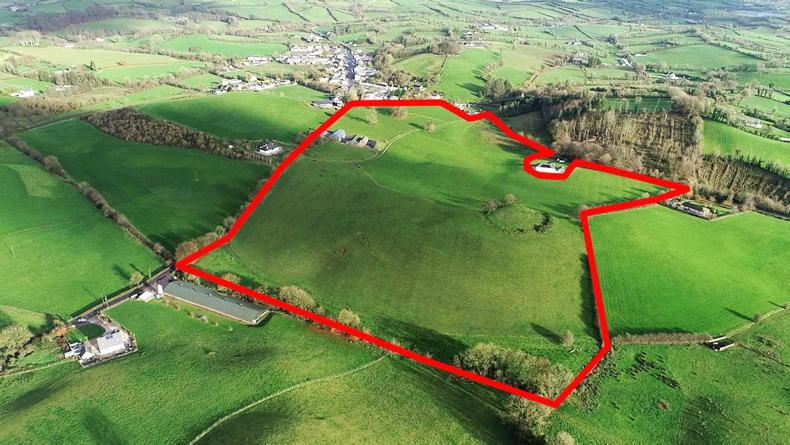
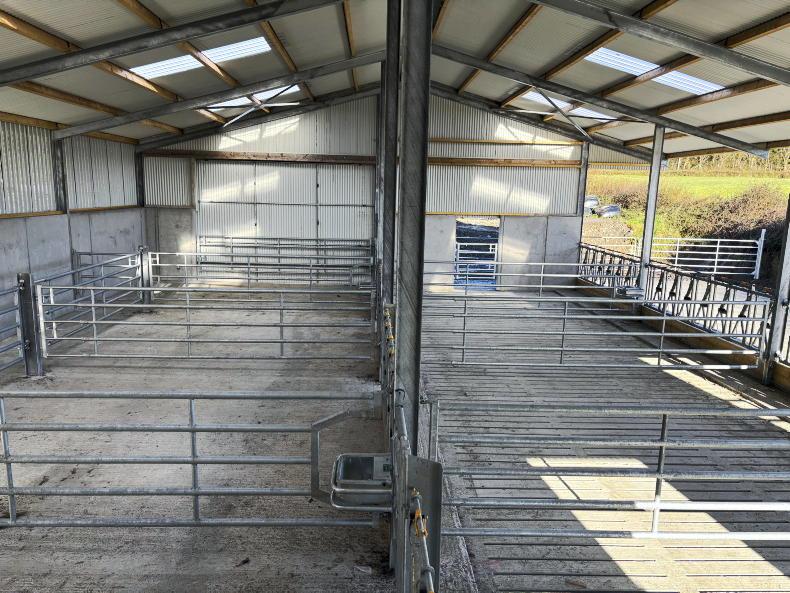
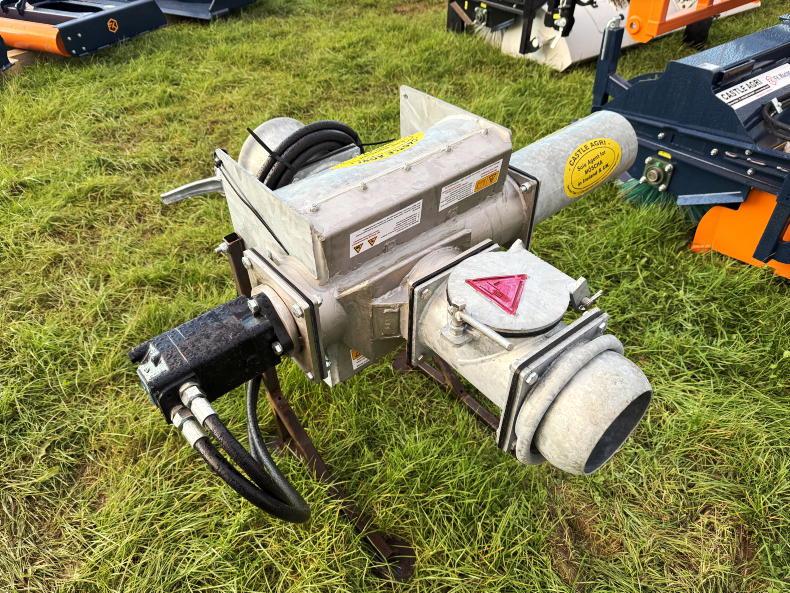
SHARING OPTIONS